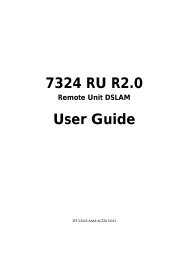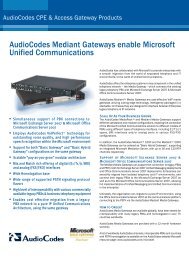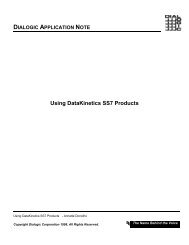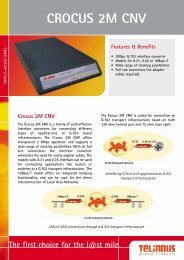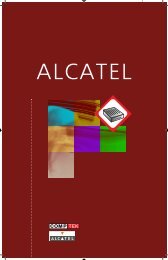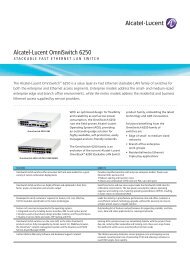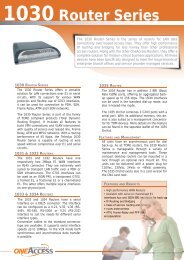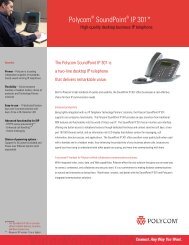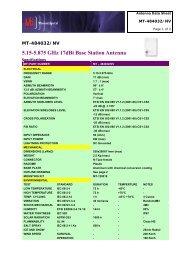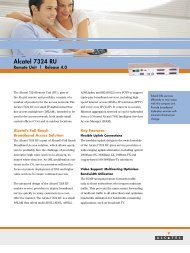Intel® Signaling System 7 Solutions - CompTek
Intel® Signaling System 7 Solutions - CompTek
Intel® Signaling System 7 Solutions - CompTek
Create successful ePaper yourself
Turn your PDF publications into a flip-book with our unique Google optimized e-Paper software.
ISUP / TUPCustomer ApplicationApplication Part(GSM-MAP, IS-41,INAP)TCAP◗ Global <strong>System</strong> for Mobile Communications-MobileApplication Part (GSM-MAP), Interim Standard-41(IS-41), and Intelligent Network Application Protocol(INAP) These are transaction-based services that allowdevelopment of applications such as Short Message Service,and access to Home Location Register (HLR)/Visitor LocationRegister (VLR) for wireless networks, and other IntelligentNetwork applications.NOTE: IS-41 is also known as TIA-41.SCCP1.3 Advantages of SS7MTP3MTP2MTP1Figure 2: SS7 Protocol Architecture1.2 Protocol ArchitectureSS7 is a layered software architecture that consists of messagetransfer and user parts.Message Transfer Part (MTP)◗ MTP1-3 (transport) MTP provides the physical, link, andnetwork layer functions. The overall purpose of MTP is totransport information reliably from the upper layers (includingthe user parts and SS7 applications) across the SS7 network.User Parts◗ ISDN User Part/Telephone User Part (ISUP/TUP)ISUP/TUP provides standards-based and network-specific callcontrol services for wireless and wireline public networks◗ Signal Connection Control Part (SCCP) SCCP providesaddress resolution services (i.e., global title) for locatingservices in the network◗ Transaction Capabilities Application Part (TCAP) TCAPtransports transaction-oriented data across the SS7 networkand implements standard Remote Operation Service Element(ROSE) services for applications such as GSM-MAP and IS-41. These “applications” provide Intelligent Network servicessuch as home location register or Short Message Service.◗ Faster call set up◗ More efficient use of network resources◗ A tested and reliable signaling protocol with global acceptance◗ Support for network convergence◗ Support for large, high-density, high-reliability systems◗ Scalable architecture◗ More cost-effective than Integrated Services Digital Network(ISDN) and Channel Associated <strong>Signaling</strong> (CAS)2.0 SS7-Enabled ApplicationsA field-proven, highly versatile solution, <strong>Signaling</strong> <strong>System</strong> 7 isused extensively in network and carrier-based applications andinfrastructure because of the substantial benefits it offers. Thefollowing scenarios demonstrate how you can use Intel ® SS7building blocks to create applications in different markets.VoIP GatewayVoice over Internet Protocol (VoIP) gateways enable callsplaced over an Internet Protocol (IP) based network to be routedseamlessly to telephones on the public network. That is to say,they make it possible for the circuit-switched public telephonenetwork to talk to an IP packet-based network, and vice versa.With the rapid growth of IP-based voice, and its increasingadoption by major carriers and corporations, gateways aregrowing in size and now support thousands of calls. This increasein scale and the need to implement carrier-grade IP gateways hasmade SS7 the protocol of choice for connecting IP gateways topublic telephone networks. An added advantage is that the PSTNalready uses SS7 as its signaling mechanism of choice. Supportfor SS7 is crucial if VoIP-based services are to provide telephoneservice that can connect to users on public networks.2



